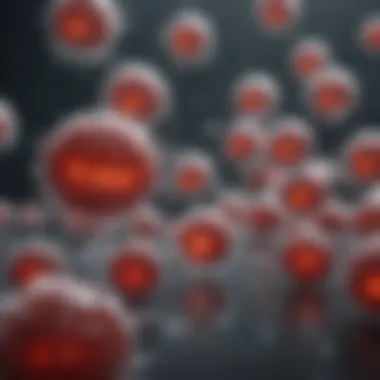Pompe Disease Treatment Strategies Explored


Intro
Pompe disease is a rare genetic disorder that has significant implications for patients and healthcare professionals alike. The disease arises from a deficiency in the enzyme acid alpha-glucosidase, leading to the accumulation of glycogen in lysosomes. This accumulation disrupts cellular function and causes progressive muscle weakness, respiratory issues, and ultimately affects overall quality of life. In the landscape of medical treatment, enzymatic replacement therapy has emerged as a cornerstone, yet the exploration of alternatives remains crucial for enhancing patient outcomes.
This article offers a comprehensive exploration of current treatment methodologies, especially enzyme replacement therapy, and examines emerging strategies for Pompe disease treatment. Its aim is to illuminate the biochemical underpinnings of the disease and the shifting paradigms in therapeutic approaches.
Article Overview
Purpose of the Article
The primary purpose of this article is to deliver an exhaustive and detailed exploration of Pompe disease treatment options. Focused mainly on enzyme replacement therapy, it seeks to demystify the complex processes involved in this treatment while also shedding light on the promising alternatives that have been gaining traction in recent years. Through a careful assessment of recent research findings and clinical outcomes, this article aims to be a resource for a diverse audience that includes medical professionals, researchers, and students alike.
Relevance to Multiple Disciplines
Pompe disease is not merely a subject of interest within the field of genetics or rare disorders. The implications of its treatment resonate across multiple disciplines, such as biochemistry, pharmacology, and healthcare policy. Understanding Pompe disease treatment can inform the development of novel treatments not just for lysosomal storage disorders, but also for other genetic diseases. Consequently, this article will attract professionals from various fields, enriching their understanding of interdisciplinary approaches to healthcare and research.
Research Background
Historical Context
The history of Pompe disease treatment has evolved markedly over the past few decades. Initially, management strategies were limited and largely focused on symptomatic relief. The advent of enzyme replacement therapy in the early 2000s marked a significant turning point in clinical care. Specifically, the introduction of Myozyme (alglucosidase alfa) changed the treatment landscape, offering a more targeted approach to address the enzyme deficiency.
Key Concepts and Definitions
To navigate the intricacies of Pompe disease treatment, several key concepts must be clearly defined:
- Glycogen Accumulation: This is the underlying pathology of Pompe disease, wherein excess glycogen builds up in tissues, leading to muscle and organ dysfunction.
- Enzyme Replacement Therapy (ERT): A therapeutic approach designed to provide patients with the enzyme that their bodies cannot produce adequately.
- Emerging Alternatives: New strategies being researched, such as gene therapy and substrate reduction therapy, which may offer additional treatment avenues.
"A comprehensive understanding of treatment options is essential for improving patient care and outcomes in Pompe disease."
"A comprehensive understanding of treatment options is essential for improving patient care and outcomes in Pompe disease."
By synthesizing this information, the upcoming sections will delve into an in-depth analysis of enzyme replacement therapy and the innovative alternatives being explored, setting the stage for a thorough understanding of Pompe treatment.
Prelims to Pompe Disease
Pompe disease is a rare, genetic disorder that can have significant implications for affected individuals and their families. Understanding the nature of Pompe disease is crucial, as it affects various aspects of health and life quality. This disease arises from a deficiency in the enzyme acid alpha-glucosidase, which is vital for breaking down glycogen within lysosomes. As glycogen accumulates in cells, particularly in muscle tissues, it leads to progressive damage. This detailed examination of Pompe disease sets the stage for understanding its treatment strategies, with a focus on enzyme replacement therapy.
Nature and Classification of Pompe Disease
Pompe disease is classified as a lysosomal storage disorder. It can be categorized into different forms based on age of onset and severity. The infantile form is typically more severe, leading to early motor and respiratory difficulties. The late-onset type, which can appear in childhood or adulthood, generally presents with milder symptoms but still causes progressive muscle weakness over time. The classification of Pompe disease is essential for determining prognosis and treatment approaches.
Genetic Basis of Pompe Disease
The underlying genetic cause of Pompe disease is mutations in the GAA gene, responsible for producing the alpha-glucosidase enzyme. There are numerous known mutations, each contributing differently to enzyme activity levels. A definitive genetic diagnosis is vital for affected families, as it helps in understanding the inheritance patterns, which follow an autosomal recessive model. Genetic counseling can support families in navigating the complexities of Pompe disease.
Epidemiology and Demographics


Pompe disease is considered rare, with an estimated incidence of about 1 in 40,000 live births globally. However, the exact prevalence can vary significantly across populations. Newborn screening programs have led to earlier detection in some regions, which may affect reported incidences. The demographics of Pompe disease highlight the necessity for research into population-specific concerns and treatment responses, ensuring that all patient groups receive the appropriate care and support needed.
Biochemical Mechanisms
Understanding the biochemical mechanisms underlying Pompe disease is crucial for developing effective treatment strategies. These mechanisms explain how glycolipid metabolism is perturbed in this condition, leading to the clinical manifestations observed in patients. Specifically, the role of certain enzymes and the accumulation of glycogen in tissues are central to the pathology of this disease. By grasping these concepts, researchers can devise interventions that target these issues directly. Moreover, insights into these mechanisms foster better clinical applications and can lead to progress in therapeutic alternatives.
Glucosylceramidase Role and Function
Glucosylceramidase is a key enzyme in lipid metabolism. It facilitates the breakdown of glucocerebrosides into glucose and ceramide, playing a critical part in maintaining cellular homeostasis. In the context of Pompe disease, the deficiency of glucosylceramidase results in the pathogenic buildup of glycogen within lysosomes, leading to cellular dysfunction. This accumulation predominantly affects muscle cells, and subsequently, muscle weakness is a hallmark symptom of the disease.
The enzyme's absence disrupts normal cellular processes, contributing to the overall pathology. Therapeutics that aim to enhance glucosylceramidase activity or substitute its function can potentially ameliorate symptoms. Furthermore, exploring glucosylceramidase's interactions with other cellular mechanisms offers significant insight into advancing treatment options.
Pathophysiology of Glycogen Accumulation
The pathophysiology of glycogen accumulation in Pompe disease involves complex cellular and molecular processes. In healthy individuals, glycogen is properly stored and utilized. However, in Pompe disease, defective lysosomal enzymes halt normal degradation. This leads to excessive glycogen storage within lysosomes, resulting in cellular swelling and ultimately cell death.
Glycogen accumulation has far-reaching effects. Skeletal, cardiac, and smooth muscle functions can be severely compromised. The domino effect causes progressive muscle weakness and affects respiratory functions as well. Patient symptoms often correlate with the extent of glycogen deposition, underlining the biochemical processes' relevance to clinical outcomes. Understanding this pathophysiology supports ongoing research into potential therapies, including gene therapy and innovative pharmacological agents.
"A comprehensive exploration of these biochemical mechanisms provides the foundation for future treatment innovations and paving pathways toward improved patient care in Pompe disease."
"A comprehensive exploration of these biochemical mechanisms provides the foundation for future treatment innovations and paving pathways toward improved patient care in Pompe disease."
Thus, focusing on the biochemical mechanisms offers a clearer perspective on how to tackle Pompe disease and develop targeted therapeutic interventions.
Current Treatment Approaches
Understanding the current treatment approaches for Pompe disease is fundamental for managing this condition effectively. The primary method used is Enzyme Replacement Therapy (ERT), which has shown significant benefits for many patients. Additionally, supportive therapies play a crucial role in enhancing the quality of life for individuals with Pompe disease. These therapies encompass physical therapy, nutritional support, and psychosocial interventions. Collectively, these strategies aim to improve patient outcomes, slow disease progression, and address the various needs of individuals affected by Pompe disease.
Enzyme Replacement Therapy (ERT)
Mechanism of Action
Enzyme Replacement Therapy primarily aims to restore the activity of acid alpha-glucosidase, the enzyme deficient in those with Pompe disease. This therapy introduces a synthetic version of the enzyme into the patient's system. The primary benefit of this mechanism is its ability to reduce glycogen accumulation in cells, consequently improving muscle function and overall health. ERT is a prominent choice due to its established efficacy in many patients, leading to improved outcomes in terms of muscle strength and respiratory function. However, it is vital to monitor the body's response as not all patients may exhibit the same levels of effectiveness, with some experiencing allergic reactions.
Administration and Dosage
The administration of ERT typically occurs via intravenous infusion, with recommended dosing schedules based on individual patient needs. This method allows for immediate delivery of the enzyme directly into the bloodstream. A key characteristic of this approach is the treatment's flexibility, as healthcare providers can adjust dosages depending on patient response and therapy tolerance. The trade-off is that the infusion process can be time-consuming, often taking several hours, and requires a healthcare setting for monitoring during the infusion period. This may pose an inconvenience for some patients.
Clinical Efficacy
Clinical efficacy refers to how well ERT works in real-world settings. Studies have shown that ERT significantly enhances clinical parameters such as muscle strength and respiratory function. A noteworthy aspect is that while it may not completely halt disease progression, the therapy can notably improve the quality of life for patients. Nevertheless, the variability in response among individuals raises questions regarding long-term benefits, suggesting the necessity for personalized approaches to complement ERT.
Supportive Therapies
Physical Therapy
Physical therapy is a critical component of supportive care for individuals with Pompe disease. It aims to maintain mobility and enhance muscle strength through tailored exercise regimens. The primary advantage of physical therapy is its potential to alleviate musculoskeletal complications. Regular sessions can also provide patients with essential techniques to improve their functional independence. However, the effectiveness of physical therapy can depend on the skill of therapists and the individual’s engagement in their own recovery process.


Nutritional Support
Proper nutritional support is vital in managing Pompe disease. A balanced diet can help address specific energy needs of patients. Ensuring adequate caloric intake helps in maintaining muscle strength and overall health. Nutritionists often recommend a diet rich in proteins and essential nutrients for optimal support. The unique feature of nutritional support is its ability to address coexisting conditions that may arise due to muscle weakness. However, patients must navigate dietary restrictions carefully, as poor dietary choices can lead to additional complications.
Psychosocial Interventions
Psychosocial interventions are crucial in providing comprehensive care for patients with Pompe disease. These interventions focus on the emotional and mental health aspects of living with a chronic condition. Access to counseling, support groups, and therapy sessions can bolster resilience in patients. The focal point is to create a supportive environment that encourages mental well-being alongside physical health. However, the challenge lies in ensuring that these services are accessible and tailored to individual patient needs.
Emerging Treatment Options
Emerging treatment options play a crucial role in the ongoing pursuit of effective management strategies for Pompe disease. This section of the article outlines novel approaches that are currently being explored, emphasizing their potential benefits and considerations as they move towards clinical implementation. As traditional methods face limitations, these innovative strategies could greatly enhance patient outcomes and provide new hope for those affected by this rare genetic disorder.
Gene Therapy Innovations
Gene therapy represents a groundbreaking frontier in treating Pompe disease. This approach involves correcting or compensating for the defective GAA gene responsible for the condition. Researchers are investigating various vectors, notably adeno-associated viruses (AAV), to deliver functional copies of the GAA gene to patient cells. The successful application of gene therapy could lead to sustained production of the acid alpha-glucosidase enzyme, which is deficient in Pompe disease.
The advantages of gene therapy include:
- Long-term effects: A one-time treatment may reduce the need for lifelong enzyme replacement therapy.
- Reduced treatment burden: Patients may experience fewer hospital visits and treatment-related complications.
- Potential for broader impact: The systemic nature of gene therapy could address both infantile and late-onset forms of Pompe disease.
However, challenges remain. There are concerns about immune responses to the viral vectors and ensuring safety. Long-term studies are essential to assess therapeutic efficacy and possible adverse effects.
Novel Pharmacological Agents
Pharmacological advancements also show promise in offering new therapeutic pathways. Several novel agents are under investigation that aim to enhance the delivery and efficacy of the enzyme replacement therapy or target disease mechanisms more directly. Noteworthy candidates include small molecules designed to improve enzyme activity or facilitate better cellular uptake.
Current studies suggest that by modulating specific pathways, these agents could enhance the effectiveness of existing treatments.
Key points regarding novel pharmacological agents include:
- Mechanism of action: Understanding how these new drugs interact with cellular processes is vital for their future use.
- Patient variability: Individual responses to pharmacological agents can differ, requiring ongoing research for personalization of treatment.
- Safety profiles: Rigorous clinical trials are needed to establish the safety and effectiveness of these agents before any potential wide-scale adoption.
Clinical Trials Overview
Clinical trials serve as the bedrock for validating new treatment approaches. They assess the safety and efficacy of potential therapies in human subjects and play a pivotal role in pushing the boundaries of Pompe disease treatment options. Currently, various trials are focused on both gene therapies and pharmacological agents.
Each trial is invaluable in generating data that helps healthcare providers understand the impact of emerging therapies. Moreover, engaging patients in these studies is essential for advancing knowledge and developing effective treatments.
The following points highlight crucial aspects of clinical trials in Pompe disease:
- Phases of Trials: Trials progress through phases, with each phase increasing the number of participants and refining the treatment approach.
- Inclusion Criteria: Ensuring that trial participants reflect the broader Pompe disease population is important for generalizability of results.
- Outcome Measures: Defining clear, relevant endpoints for efficacy and safety measures helps in evaluating treatment success.
"Emerging treatment options are invaluable as they pave the way for innovative strategies that may ultimately reshape the landscape of Pompe disease management."
"Emerging treatment options are invaluable as they pave the way for innovative strategies that may ultimately reshape the landscape of Pompe disease management."
In summary, emerging treatment options reflect a shift towards innovating and personalized care in Pompe disease. Gene therapy, novel pharmacological agents, and clinical trials compose the foundation of future therapies aimed at improving patient quality of life. The next few years will be critical as research continues to evolve.


Challenges and Limitations
Understanding the challenges and limitations of Pompe disease treatment is crucial for healthcare professionals and researchers. Analyzing these factors not only informs ongoing clinical practices but also enhances the development of future therapies. The complexities stemming from treatment may involve adverse effects that can influence patient compliance, as well as access and affordability concerns that may restrict the reach of effective interventions.
Adverse Effects of ERT
Enzyme Replacement Therapy (ERT) stands as the primary treatment for Pompe disease, yet it is not without its drawbacks. Patients receiving ERT often report a range of adverse effects that can deter their treatment progress. These may include:
- Immune reactions, leading to symptoms such as fever or chills
- Injection site reactions, including pain, redness, or swelling
- Infusion-related symptoms such as headache and nausea
Such adverse effects can complicate treatment plans and necessitate dose adjustments or changes in administration strategies. The emotional and psychological impacts of dealing with these side effects can also weigh heavily on patients, further complicating their condition and response to therapy. Thus, a comprehensive understanding of these adverse effects is essential in improving patient management and therapeutic outcomes.
Access and Affordability Issues
Access and affordability of Pompe treatments is a pressing concern in the clinical landscape. Although ERT has proven effective, its high costs pose a significant barrier for many patients. The following factors contribute to access challenges:
- Insurance coverage discrepancies: Not all health insurance plans fully cover ERT, leading to overwhelming out-of-pocket expenses.
- Geographic limitations: Availability of specialized centers for administering ERT can be sparse, particularly in rural or underserved regions.
- Socioeconomic factors: Patients from lower-income backgrounds may struggle to afford treatment, ultimately impacting their health outcomes and quality of life.
Efforts toward expanding access to treatment must consider these factors. Policymakers and stakeholders in the healthcare sector need to work collaboratively to address these issues. An increase in awareness, funding, and support programs can enhance patient access, ensuring that effective treatment is not a privilege but a right for all individuals battling Pompe disease.
Addressing the challenges and limitations in Pompe treatment is fundamental to improving the quality of care and achieving better outcomes for patients.
Addressing the challenges and limitations in Pompe treatment is fundamental to improving the quality of care and achieving better outcomes for patients.
Future Directions and Research Needs
The landscape of Pompe disease treatment is evolving. As researchers continue to explore the complexities of this condition, several future directions and research needs become essential to improve patient outcomes. Emphasis on exploring integrative approaches and personalizing therapy plays a crucial part in advancing treatment strategies.
Integrative Approaches in Treatment
Integrative approaches represent a holistic view of treatment for Pompe disease. They emphasize the use of ** multidisciplinary methods**, combining various therapeutic modalities to improve patient care. This can include the integration of enzyme replacement therapy (ERT) with supportive therapies such as physical rehabilitation, nutritional counseling, and psychosocial support.
- Enhanced Overall Care: By employing multiple treatment options, healthcare providers can address the numerous aspects of the disease. This approach not only targets the biochemical deficiencies but also comprehends the psychosocial challenges faced by patients.
- Collaboration Between Specialists: An effective integrative strategy requires collaboration among different healthcare professionals. Neurologists, physiotherapists, dietitians, and mental health experts must work together to create customized care plans that address both physical and emotional needs.
- Patient Engagement: Engaging patients in their treatment decisions can lead to better adherence and satisfaction. This can be facilitated through shared decision-making processes, where patients are encouraged to participate actively in selecting their treatment pathways.
Personalization of Therapy
Personalization of therapy is an advancing frontier in the management of Pompe disease. The focus here is to tailor treatment protocols based on individual patient characteristics, genetic profile, and the severity of the disease.
- Genomic Insights: With the advent of genetic testing, healthcare providers can identify specific mutations responsible for Pompe disease in patients. This knowledge can guide therapy choices and determine how a patient may respond to certain treatments.
- Dynamic Treatment Plans: As patients progress, their treatment plans may require adjustments. A personalized approach means that therapies can be modified to suit changing conditions or responses to initial treatment.
- Role of Biomarkers: Research into biomarkers can further refine personalization. Identifying biomarkers that correlate with response to therapy can lead to more effective monitoring and adjustments in treatment over time.
"Future research should focus on developing integrated treatment models and personalized strategies to meet the specific needs of each Pompe disease patient. These advancements can lead to more efficient management and improved quality of life."
"Future research should focus on developing integrated treatment models and personalized strategies to meet the specific needs of each Pompe disease patient. These advancements can lead to more efficient management and improved quality of life."
Epilogue
In this article, we have explored the multifaceted approaches to treating Pompe disease, highlighting the significance of enzyme replacement therapy (ERT) and the emerging alternatives. Each section of the article has contributed to a holistic understanding of the current landscape of Pompe treatment.
Importance of Treatment Strategies
The treatment options discussed, including ERT, supportive therapies, and innovative pharmacological agents, underscore the dynamic nature of Pompe disease management. ERT remains the cornerstone of treatment, providing essential enzyme supplementation. However, as the field evolves, it is critical to remain abreast of novel therapies, particularly gene therapy innovations and new drugs that may enhance clinical outcomes.
Research and Future Directions
The exploration of integrative approaches and the personalization of therapy is paramount. Personalized medicine promises to tailor treatment regimens to individual patients based on specific genetic and biochemical profiles. This can lead to enhanced efficacy, fewer side effects, and improved overall patient satisfaction. Continuing research is vital to identify optimal combinations of ERT with emerging therapies.
Considerations for Practitioners and Researchers
For professionals in this field, understanding the complexities of each treatment modality is crucial. Practitioners must weigh the benefits and limitations of ERT alongside patient-specific factors. Researchers are encouraged to focus on novel treatment pathways that may revolutionize care.



